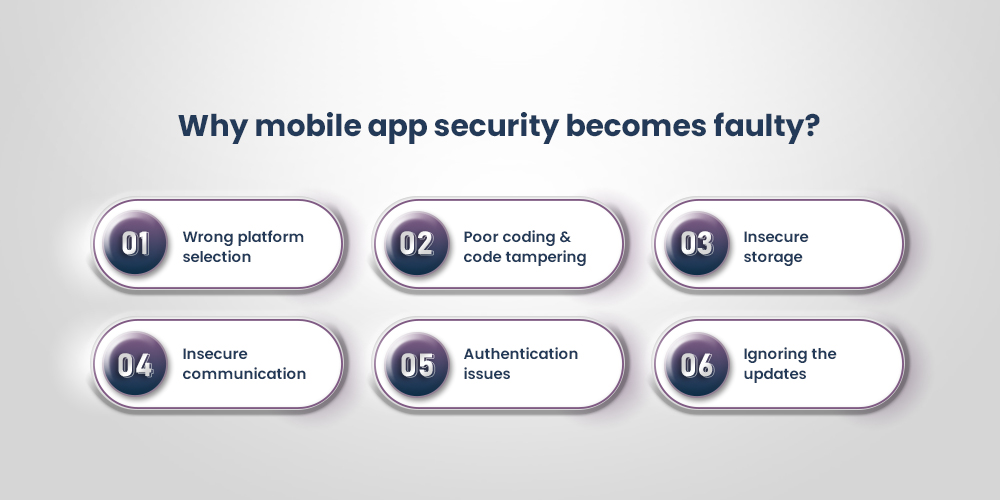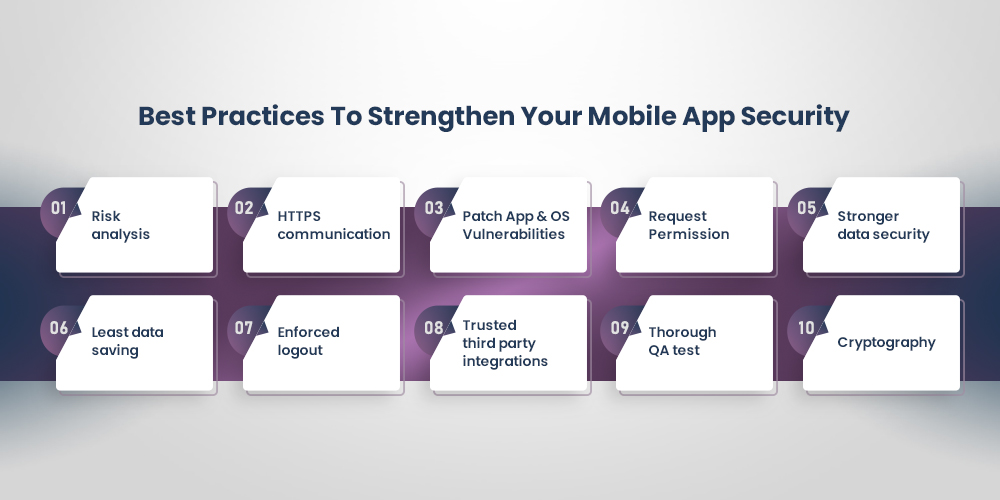> Products – partially correct!
> Lucrative deals – again, partially correct!
> Customer service – also partially correct!
But one factor that overshadows these exclusive deals and high-quality products/services in terms of holding users on a mobile app is SECURITY. Can you even imagine using an app where you have security issues? The answer will probably be NO, right? Right now, users often download and install an app to order something, pay bills, book tickets, etc. conveniently. However, a minor security issue can also prompt the user to uninstall it. Security issues can essentially ruin an app’s credibility as a reliable option for users. Security on an app is tricky; unless you have clarity, it may go wrong. You’re about to learn a lot about mobile app security in this blog.
Table of Contents
- Mobile App Security – What Is It?
- How Does It Work?
- Components Of Tight Security On Mobile App
- Importance Of Mobile App Security
- Common Reasons Of Security Issues In Mobile Apps
- Bad Security On Apps Cost Brands Millions
- Common Security Issues With Mobile Apps
- Best Practices For A Tight Security On Mobile Apps
- Top 5 Security Testing Tools For Your Mobile App Security
- Wrapping Up
Mobile App Security – What Is It?
It refers to protecting a mobile app from all types of threats. At present, there are a handful of security issues in the digital world that can make mobile apps less trustworthy. Be it an android or iOS app, these are inevitable, but while developing the app, one can cleverly deal with these and avoid these.
How Does It Work?
Mobile app security aims at preventing external threats to trespass into the mobile app. Broadly, it builds a wall between the threats and whatever is stored inside the app to protect users’ data.
Components Of Tight Security On Mobile App
The critical components of mobile app security include:
- Authentication
- Authorization
- Encryption
- Confidentiality
- Data protection
Enhancements in Mobile App Security: Play Integrity API Updates
Google recently introduced significant updates to the Play Integrity API, aimed at further enhancing the security and integrity of apps on the Google Play Store. These updates focus on preventing unauthorized access and protecting users from potential threats.
New Features Include:
- App Access Risk: This feature helps to determine if an app is at risk of unauthorized access. It identifies whether another app could be capturing the screen, displaying overlays, or controlling the device. While certain accessibility features are crucial for users with disabilities, they can also be exploited by malicious apps to compromise user security. By providing visibility into these risks, developers can take appropriate measures to protect their apps and users without negatively impacting legitimate accessibility tools.
Example: For instance, imagine you have a banking app installed on your phone. If another app on your device is able to capture screenshots of your banking app while it’s open or display fake login screens over it, that’s a significant security risk. With the App Access Risk feature, you can identify such risks and take appropriate measures to protect their apps and users.
- Play Protect Verdict: This feature integrates Play Protect, Google’s built-in malware protection for Android, into the Play Integrity API. It allows you to check if Play Protect is enabled and if it has detected any known malware on the device. By enabling apps to verify the Play Protect status, it can be ensured that apps run in a secure environment, thereby safeguarding user data and enhancing trust in their apps. This feature helps in detecting and preventing the spread of malware.
Example: Let’s say you download a new app from the Play Store. With the Play Protect Verdict, your app can check if Play Protect is enabled on your device and if it has detected any known malware. If Play Protect detects any threats, your app can take necessary actions to ensure the safety of your data and the integrity of the app.
- Recent Device Activity: This feature helps detect and respond to abnormal patterns in device behavior, such as a high volume of requests which could indicate automated traffic or an attack. Google aims to protect apps from bot attacks and automated misuse, which can lead to data breaches, service disruptions, and fraudulent activities. By monitoring recent device activity, developers can identify suspicious behavior early and take preventive actions to mitigate potential threats.
Example: Suppose your app suddenly experiences a surge in requests from a particular device, which could indicate automated traffic or a potential attack. With the Recent Device Activity feature, you can monitor such activities and take preventive actions to safeguard the app and its users.
These updates comes with powerful features to identify and respond to security threats proactively, thereby reinforcing trust in the Android ecosystem.
This addition to our understanding of mobile app security complements the existing critical components, further fortifying the integrity and reliability of mobile applications.
Importance Of Mobile App Security
 Now, moving on to the importance of mobile app security. There is no second thought that security brings certain benefits to a mobile app. Some prime benefits are mentioned below:
Now, moving on to the importance of mobile app security. There is no second thought that security brings certain benefits to a mobile app. Some prime benefits are mentioned below:
1. Trustworthiness
An app with weak security fails to be trustworthy to its users. In short, users do not take a second to uninstall the app when they find a minimal security issue. Research shows that nearly 19% of customers stop using any online solution forever on finding security issues. So, tight security is essential to get that trustworthiness to the mobile app.
2. Conversion
Several researches have shown that security risks first impact the mobile app load speed and that slow load speed alone reduces conversions by 7%. Additionally, security risks make users prone to transact less on any app. On the other hand, fixing the security issues on mobile apps right at the beginning can get almost 40% higher conversions compared to other apps.
3. Retention
Adding a trust factor to a mobile application slowly but surely leads to user retention as well if the product is helpful to the users. In the near future, they may recommend others to use the app, which can increase conversion, revenue, loyalty, and much more. And all these will be the result of tight security on the app.
And some direct impacts of weak security in the mobile app include:
- Bad reputation
- Drop in customers
- Drop in transactions
- Revenue loss
So, a mobile app with security glitches will surely face its consequences. This is why knowing the loopholes, common security issues, and best practices to avoid the problems is very important.
Check out our best guides:
- Negative Customer Reviews: What Should You Do?
- 9 Effective Tips For Successful Mobile App Branding
- 8 Ways A Mobile App Can Reduce Shopping Cart Abandonment
- How To Use Mobile App Retention Strategies To Win Loyal Customers in 2023?
Common Reasons Of Security Issues In Mobile Apps

Time to find out the loopholes that make mobile app security flawed. There are quite a few factors for the same:
1. Wrong Platform Selection
Wrong platform can be a major glitch when it comes to mobile app security. If you have not selected a secure platform, the entire app-making process will go wrong.
Start-ups often opt for the less-known app-making platforms since they offer functionalities at a pretty low cost. But, it sometimes compromises security. As a result, the app fails to build trust among users.
2. Poor Coding And Code Tampering
Coding, too, can be a factor behind low security on a mobile app. Developers of premium mobile apps prefer strong and unique codes. It makes the mobile app ultra-secure from all possible threats. Along with these, the failure to detect the changes in codes, APIs, and resources from any malware can modify the mobile app’s behavior. It will also increase the risk factor in the mobile app.
3. Insecure Data Storage
Data storage is another major loophole in mobile apps. Sometimes, apps fail to encrypt sensitive data, which causes data loss and data stealing.
4. Insecure Communication
Public networks used in mobile apps used in data transmission can increase the risk of security attacks in a mobile app. It is a prime security threat to mobile apps.
5. Authentication Issues
A mobile app can have some vulnerabilities with the identity management system. It allows malicious software to gamble with the authentication of mobile apps.
6. Ignoring The Updates
App makers often ignore updates on the mobile app. As a result, the mobile app becomes less capable of handling latest security threats. It makes the mobile app’s security flawed.
Along with these 6 common causes, some other reasons behind weak security in mobile apps are:
- Insecure authorization
- Improper cryptography
- Reverse engineering
- Extraneous functionality
Bad Security On Apps Cost Brands Millions
Several pieces of research were made, and it was found that the most popular apps had security risks once, but their tech team had mitigated it in the right direction.
Here are a few to name for the same:
- WhatsApp Messenger
- Facebook Messenger
- eBay
- WinZip
- Yahoo Browser
- ShareIt
- AliExpress
All these apps lost millions of dollars in just a few minutes due to security issues. Popular mobile apps often have the potential for security threats. Now, let’s check common problems on a mobile app:
Common Security Issues With Mobile Apps

In different mobile apps, different security issues may occur – here are the common ones
1. Information Leak
Due to weak security on mobile apps, the biggest issue that occurs in mobile apps is the information leak. On a mobile app, massive user data is stored, which may get leaked due to IP theft.
2. Insufficient Transport Layer Protection
Security issues break the transport layer protection on the mobile app by harming all the transmissions. It also leads to account theft, phishing, site exposure, etc.
3. Poor Input Validation
Another common issue due to bad security on mobile apps is bad input validation. When attacked by malware, apps cannot read the inputs correctly. As a result, it cannot return accurate results to the users.
Malware actually corrupts the entire encryption process. As a result, the app cannot read the user’s command. Hence it cannot return exact results.
4. Weak Server Side Control
Mobile apps with client-server architecture are prone to face this issue. Here, end-users interact with the client servers. On the developers’ side, the server component interacts through API. Any security threat weakens the server-side control as well.
As a result, a mobile app is exposed to
- Code vulnerabilities
- Configuration glitches
- Different security mechanisms
5. Reverse Engineering
Reverse engineering is the process of decrypting the entire application and rebuilding it with different source codes. It is also known as code obfuscation. When this problem occurs, any human or automated tools fail to understand the work process of the app.
6. Rooting/Jailbreak
It is another common security issue in Android and iOS apps. Rooting is the problem where a phone is restricted from running an app. Jailbreaking is the users’ access to the OS root to manage the functions.
Some other issues include:
- Malicious code injection
- Mobile botnets
- Security misconfiguration
- No penetration testing
Now, let’s not talk only about the problems. Let’s dive into the solutions too.
Best Practices For A Tight Security On Mobile Apps

Security issues are inevitable, but these can also be prevented. So, have a look at the best practices to avoid the security risks on your mobile app:
1. Prior Risk Analysis
Risk analysis can save an app from upcoming security glitches. A good risk architecture and contingency plan are essential in order to prevent security risks on the app.
For this, while making the app, the makers need to list the possible security issues that may occur while using the app. Based on this, alternative solutions can be integrated into the app to make it ultra-secure.
Unless a risk analysis is done prior, the app makers will have to spend a considerable amount of time to understand the type of security issue that occurred. Then they can start looking for a solution. By this time, some consumers may step back.
2. HTTPs Communication
The need for secure communication in the app is now essential, so HTTPS has already replaced HTTP communication. Yet, not all mobile apps have adopted HTTPS till now, and they are prone to face security issues anytime soon. The TLS used to encrypt the ordinary HTTP requests in HTTPS is much more secure, so include it in your app-making.
3. Mitigate App And OS Vulnerabilities
We all know that the process of making an android app and iOS app are different. Also, there are different app-making restrictions in different operating systems. In case these restrictions are not properly followed, the app may not instantly stop working, but gradually, there will be some security risks. This is why we recommend the app makers to follow the specific rules of the OS to make the app healthy and secure.
4. Permission System
Include a permission system to make your mobile app secure to the users. Your users must not feel that your app is saving their personal information without asking them. So, ask them beforehand, and if they deny the permission, you can display what happens next time. Do the same in case they allow permission.
5. Stronger Data Security

File-Level & Database Encryption, Multi-factor authentication, Source-code, and cache encryption are some methods to strengthen data security in mobile apps. Code encryption will keep all the data saved inside the app, and the users will never have to worry about data loss.
Along with this, multi-factor authentication can also strengthen the data security on the mobile app – so pay attention to it. All these will keep your backend highly secured and lessen the possibility of code tampering. Additionally, you can take help of IPC mechanisms and prevent any type of data breach.
6. No Password And Sensitive Data Saving
At present, the policy of not saving any sensitive information about the users is very much in trend. But, sometimes saving this information lessens users from reentering the details every time they log in. That’s why asking for credentials before displaying any delicate information can also be a good practice in mobile app security.
7. Enforced Logout
The apps that never log out the users are sometimes much more exposed to security issues than those with an enforced logout system.
Indeed, some users may get disgusted by logging in every time they open the app, but ultimately, it will benefit them. An auto login system or social login system can reduce the hassle of typing the ID and password every time.
8. Trusted Third Party Integrations
Integrations are the must-haves in mobile apps. But to avoid security issues, ensure the third-party plugins or integrations you pick are from trusted sources. As a result, users face numerous security issues when they start accessing these integrations. So, verify the integrations before adding them to your mobile app. For this, check the reviews, and reach its users if possible before adding that plugin to your mobile app.
9. Thorough QA Test

Once your app is developed, invest sufficient time in its QA testing. The testers test the app in different scenarios and check if there is any gap. Before delivering the app to the merchants, the testers make sure that its users do not have any complaints – be it regarding security or load speed, or handling high-traffic situations.
Merchants often do not pay attention to QA testing – once the apps are developed, they directly go for publishing it on app stores. As a result, the end-users come across different problems, including security issues while using the mobile app. For this reason, we highly recommend thorough QA testing before launching the app.
Also, it is a good practice to have a security team that can pen-test your app anytime and reveal if there are any vulnerabilities or bugs without wasting any time. Such proactive monitoring will make your mobile app secure. This team will also be responsible for code audits and further authorization and authentication.
10. Cryptography
Last but not the least, the use of the latest cryptographic algorithms can strengthen the security of the app. At present, encryption models like AES, MD5, and SHA1 are very much in trend for security purposes. Also, performing manual penetration and threat modeling can offer your high-end app security.
Bonus Tips
- Malware scanning
- Concrete API strategy
- Implement a VPN
- Optimize data caching
Get an app with power-packed security with MageNative mobile app builder today!
Top 5 Security Testing Tools For Your Mobile App Security
We have said so much about testing – so let’s wrap up this article with 5 handpicked security testing tools for your apps:
Wrapping Up
A foolproof security on the mobile app can often be dicey because the hackers are way too smart. As a result, IP thefts are prevalent.
But, it does not mean you cannot protect your mobile app from external security threats. You need to be brighter than the hackers and block all the paths from where they can access your data. So, take faster action, monitor everything proactively, and be with the latest trends to secure your mobile app.
About MageNative
MageNative is a leading app-building platform that facilitates app creation for business owners regardless of their knowledge of the technical nuances involved. At MageNative, we convert ideas into scalable mobile apps instantly and conveniently.
Check out the most successful Case studies of MageNative.
About The Author
I love navigating the world of SaaS with finesse. As an SEO enthusiast and seasoned Copy Writer, I'm here to transform tech-speak into compelling narratives that resonate with online merchants. With a penchant for alliteration and a touch of humor, I bring a unique flair to SaaS content.
Related Posts
A Smarter Approach to Abandoned Cart Recovery
Abandoned cart recovery is one of the most important yet…
Turn Customer Behavior Into Sales With a Smart Data-Driven Marketing Approach
A data-driven marketing approach isn’t just a buzzword—it’s a necessity….
The Role of Customer Support for Business Growth
Did you know that 97% of consumers say customer service…